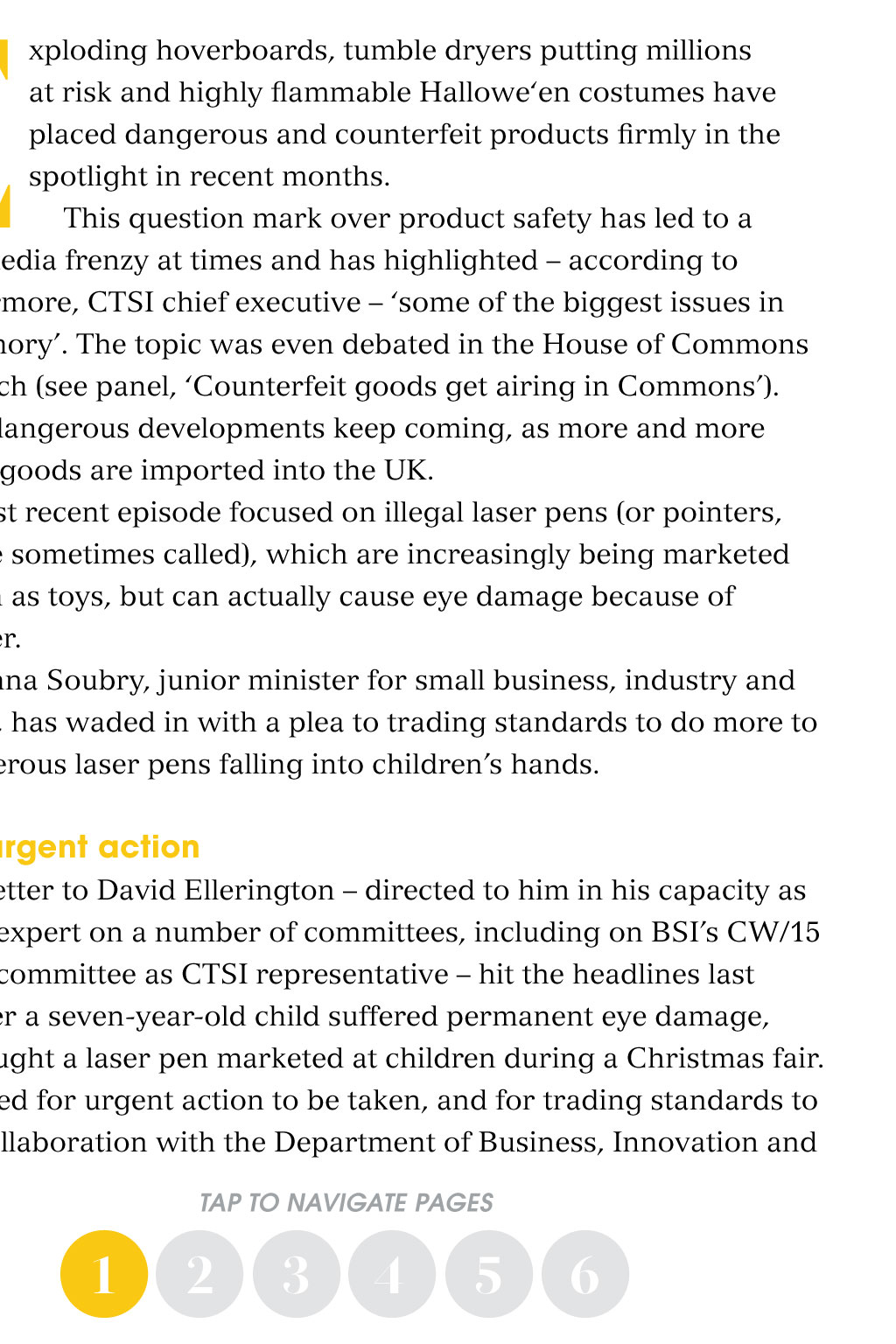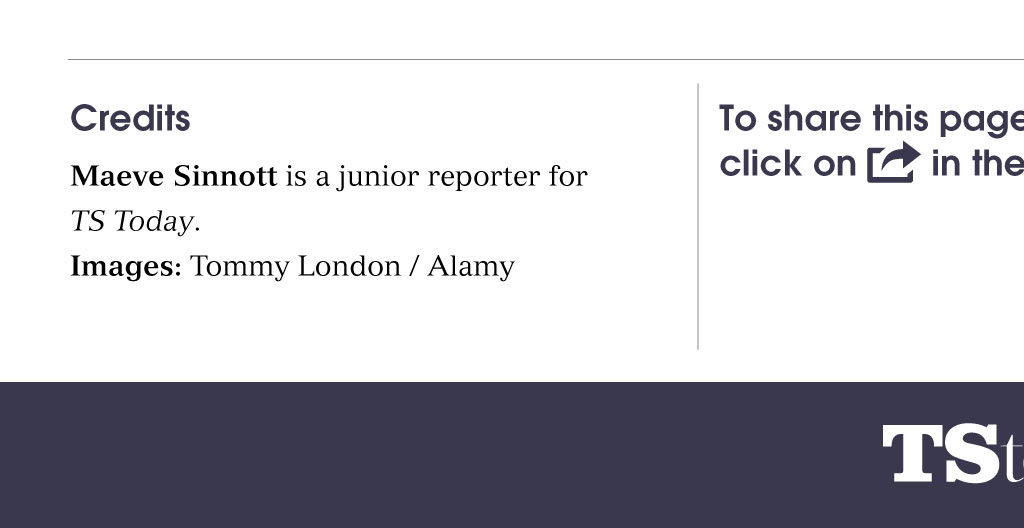












Dangerous goods: laser pens In this feature media frenzy call for action initiatives Pointing out the dangers Anna Soubry MP put dangerous laser pens and trading standards in the spotlight. Maeve Sinnott details the rapid response to a difficult problem, despite it happening during an era of deep cash cuts COUNTERFEIT GOODS GET AIRING IN COMMONS PRODUCT SAFET Y WHAT IS A L AS ER PEN? E xploding hoverboards, tumble dryers putting millions at risk and highly flammable Halloween costumes have placed dangerous and counterfeit products firmly in the spotlight in recent months. This question mark over product safety has led to a national media frenzy at times and has highlighted according to Leon Livermore, CTSI chief executive some of the biggest issues in living memory. The topic was even debated in the House of Commons on 22 March (see panel, Counterfeit goods get airing in Commons). Yet these dangerous developments keep coming, as more and more consumer goods are imported into the UK. The most recent episode focused on illegal laser pens (or pointers, as they are sometimes called), which are increasingly being marketed to children as toys, but can actually cause eye damage because of theirpower. Now Anna Soubry, junior minister for small business, industry and enterprise, has waded in with a plea to trading standards to do more to stop dangerous laser pens falling into childrens hands. Call for urgent action Soubrys letter to David Ellerington directed to him in his capacity as toy safety expert on a number of committees, including on BSIs CW/15 toy safety committee as CTSI representative hit the headlines last month after a seven-year-old child suffered permanent eye damage, having bought a laser pen marketed at children during a Christmas fair. She asked for urgent action to be taken, and for trading standards to work in collaboration with the Department of Business, Innovation and TAP TO NAVIGATE PAGES 1 Credits Maeve Sinnott is a junior reporter for To share this page, in the toolbar click on TS Today. 2 3 4 5 6 You might also like Kitchen killers March 2016 The big bang January 2016 Images: Tommy London / Alamy Skills (BIS) Single Market Product Safety Team to raise awareness and to up our game in relation to laser pens. Despite trading standards resources already being cut by an average of 40 per cent since 2010 with more cuts still to come, following Chancellor George Osbornes 2016 budget Soubrys call was answered within two weeks. Advice will now be circulated this month (April) to trading standards services across the country through the Product Safety Focus Group network and the Knowledge Hub. The advice outlines the risks and sets out tips to ensure consumer safety. The flow of dangerous goods hitting the headlines also comes at a time when the results of a recent governmental review into the robustness of trading standards has been held back, something Livermore has described as shifting focus from a core issue without answering any questions after the review undoubtedly found [services] are under-resourced. Those findings will now be published along with the results from a government cutting red tape review, announced in early March, which will examine all local authority-enforced regulation. Permanent eye damage The danger of laser pens first hit the headlines at the turn of the year, when a plane was forced to land after youths shone a beam from one into the cockpit. The British Airline Pilots Association has since made calls for laser pens to be classed as offensive weapons. Soubrys letter sent on 17 March outlined the incidents of young children and teenagers suffering permanent eye damage from having such pens shone directly at their eyes. Soubry wrote: I have been made aware of at least 159 such incidents since 2013 and I understand the number is increasing year on year. The law states that laser pens with the strength of more than one milliwatt (mW) are illegal to sell to the public. Soubry added: It has come to my attention that some importers and retailers appear to be ignoring the legislation and many of the products available in the UK are considerably over this limit. Action under way When Ellerington received Soubrys letter, he says he was flattered to be approached and was more than happy to assist. Action is now under way. Ellerington said: We are now in discussions with BIS officials on a project plan that links all the preventive and enforcement elements available to trading standards and our safety partners, the Royal Society for the Prevention of Accidents (RoSPA) and the Child Accident Prevention Trust (CAPT). The information recaps the responsibilities around general product safety and lists the classification of laser points. He says the project follows trading standards work around the safety of Halloween costumes and hoverboards, and takes a four-pronged approach encompassing prevention, advice, enforcement and a potential sampling programme. Tackling initiatives A safety poster with branding from BIS, RoSPA, National Trading Standards and the CAPT is being developed now and will be distributed online, mainly through social media, to raise awareness of the risks posed by laser pens. It is expected to warn that some lasers are capable of causing permanent damage, and that children should not play with them. There are plans to display the poster in nurseries and doctors surgeries before Child Safety Week, which runs from 6-12 June. Trading standards officers at port and border points have already seized a number of unsafe products, according to Ellerington, and this new project is proposing a potential sampling and testing programme of laser pens purchased online and through traditional retail outlets. Serious risk Imported devices pose a serious risk as they are often higher-powered and typically have no labels to indicate wavelengths and wattage. Discarding the device is the recommended action. Pointing laser pens at faces and eyes is the issue that has caused a substantial number of accidents in the past few months; laser beams can damage the retina. Distance from, and length of, a beam in the eye affects the amount of damage. Permanent harm can only be done by a beam of more than 500mW well over the legal limit. While it is unlikelythat people will come across something of this power, imports make it possible. The risks posed to aircraft have been outlined too, in a bid to avoid accidents. Most people do not realise that even a lowerpowered laser pointer can have a beam that can travel up to 2.2 miles before fading out; people have been arrested for shining laser beams into the eyes of pilots. Its a serious hazard, and the information warns against it. Pointing lasers at vehicles causing temporary blind spots for drivers on the road is also warned against, as is using them on animals, whether pets or to scatter unwanted animals and birds. Shining beams close to the skin is highlighted too. Beams of 200 to 300mW can be felt on the skin, while a 500mW beam will cause a slight burning sensation on the skin if pointed for any length of time. The final tip included in the information safety sheet is, topically: Dont give laser pointers to children. Sharing information The sheet also details the laser classification scheme, which is taken from BS EN 60825-1, in a bid to raise awareness of the various types that exist. Class 1 lasers are considered safe, as exposure to the beam will not result in eye injury. Laser printers and compact disc players are examples. Class 2 lasers are limited to a maximum output of 1mW. A person exposed to the beam will be protected by their own natural aversion response an involuntary action that causes the individual to blink and move their head. However, repeated, deliberate exposure may not be safe. Laser pens fall into this category, alongside barcode scanners. Class 3 lasers are higher-powered devices and can potentially cause eye injuries. Class 4 lasers have no upper restriction on output power and, as a result, can cause significant injury or pose a fire hazard. Discrepancies While the initiative is positive, and the project has the potential to prevent serious incidents and damage among the public, Ellerington finds it ironic for a government minister to be demanding more be done on these types of issues while: a referendum on EU membership is under way, and the safety of laser pens advice is based on EU legislation; the Cabinet Office is in the middle of a consultation to further cut red tape enforced by local government; and the capacity and ability of trading standards continues to be debilitated by cuts, leaving services across the country at their lowest possible ebb. While government is yet to officially acknowledge the strain trading standards services are under and the subsequent danger the government is exposing the public to at least the minister, on this occasion, has recognised the rapid response. She told TS Today: I am pleased that trading standards is going to work with us to tackle this important issue and I thank it for its quick response. Its important that the public are informed about the dangers of powerful lasers and that there are consequences for those who sell illegal lasers to consumers especially young children and those that misuse them. We quite agree. But when will government recognise that to protect the public adequately trading standards services need to be properly resourced? Laser pens (sometimes referred to as laser pointers) are small devices with a power source that projects a narrow laser beam. They can come in various beam colours and they are used as a way to point to at objects that are out of reach. Typically, the human eye can only see the dot at the end of the laser beam displayed on what it is pointing at. However, high-frequency lasers that are coloured sometimes have visible beams and are often used for astronomical classes to point out stars, or by astrology enthusiasts. Laser pointers have many purposes. In the classroom, teachers can use them for lectures. They can be a signalling tool in search and rescue missions as well as an astrological research tool. They are also helpful for large seminars to help draw peoples attention to information. Recently, however, the low costs of the lasers has made them popular as toys among children and teenagers, which has led to the lasers being used in ways that were not intended by the manufacturers. The laser pen safety project follows on from previous trading standards work on Halloween costumes and self-balancing scooters, known as hoverboards. A national sampling project tested 309 Halloween costumes across the UK and found a pass rate of 90 per cent. Reports were prepared for the Department of Business, Innovation and Skills (BIS), British Standards Institute and the EU. The work influenced a new proposal to amend the EU toy safety standard EN71-2, according to David Ellerington, whose Newcastle authority led the testing project. Business minister Anna Soubry had tasked officials to develop the sampling project after the tragic incident in which Claudia Winklemans daughter suffered injuries from a Halloween costume catching fire. Reacting to the hoverboards crisis, which erupted over Christmas, trading standards officers from the National Trading Standards (NTS) ports and border project as well as inland authorities seized and tested hoverboards, resulting in failure rates of 89 per cent of the product at the border. An initial reflections report has since been prepared by NTS and sent to BIS and the wider trading standards community. During a debate in the House of Commons on 22 March, Carolyn Harris, Labour MP for Swansea East, outlined the severe public risks posed by the rise in counterfeit electrical goods, concluding that it was costing lives. She said: This trend is being fuelled by the internet and a lack of monitoring of sales sales from well-known websites; sales from fake websites that are not based in the UK but appear to be; and sales through fulfilment houses, which are based in the UK. Her sentiment was echoed by several MPs, who fear that legislation is not up to scratch. Jim Fitzpatrick, Labour MP for Poplar and Limehouse, highlighted that the legislation is from 1994 well before the explosion of internet trading, while Martin Docherty-Hughes, SNP MP for West Dunbartonshire, said: Anyone with a bank account and internet access can import products from anywhere in the world. Harris questioned whether the level of funding for trading standards was sufficient, highlighting that investment in officers who can work online and at ports and borders is crucial for tackling counterfeit goods. MPs called on the government to take further action, with many calling for greater examination of goods entering the UK, while others stated that major online sellers such as Amazon and eBay should take responsibility for goods sold on their sites.